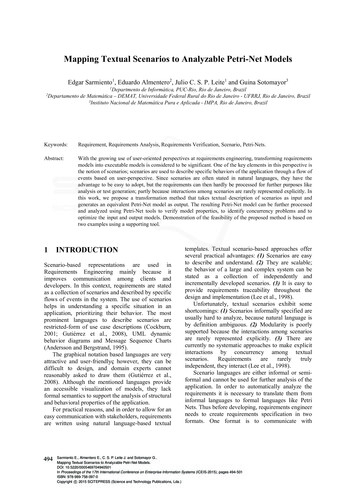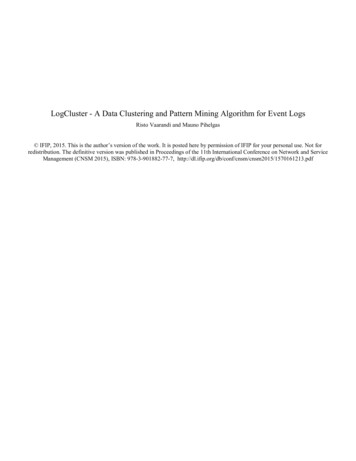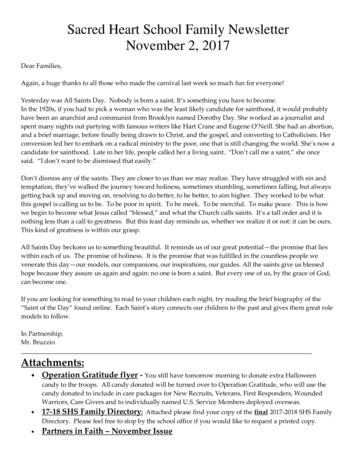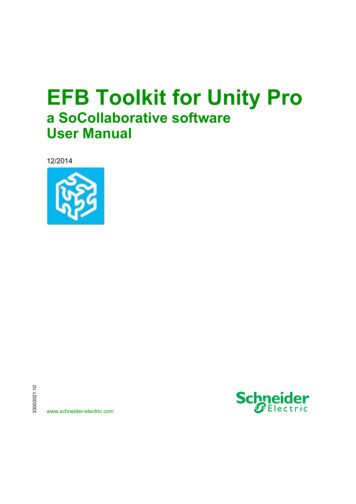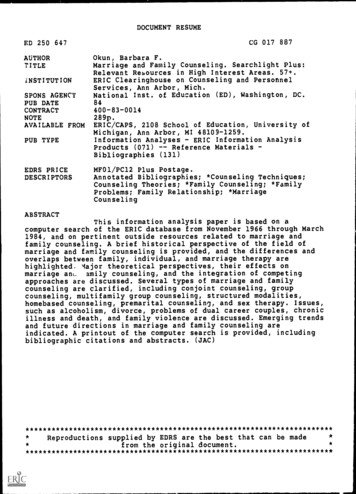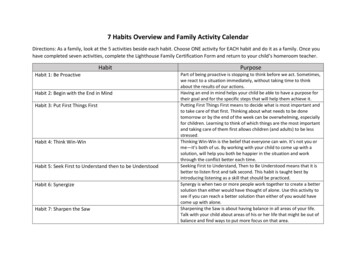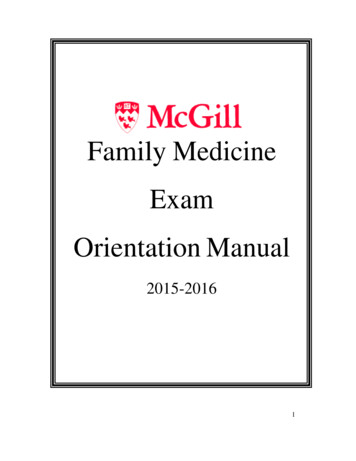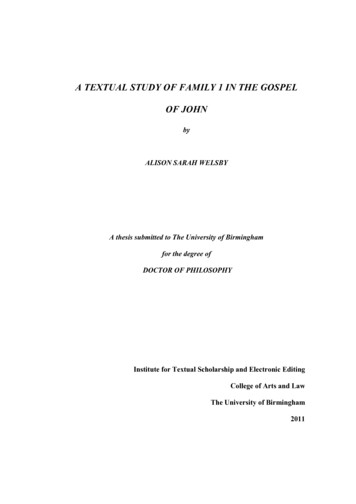
Transcription
A TEXTUAL STUDY OF FAMILY 1 IN THE GOSPELOF JOHNbyALISON SARAH WELSBYA thesis submitted to The University of Birminghamfor the degree ofDOCTOR OF PHILOSOPHYInstitute for Textual Scholarship and Electronic EditingCollege of Arts and LawThe University of Birmingham2011
University of Birmingham Research Archivee-theses repositoryThis unpublished thesis/dissertation is copyright of the author and/or thirdparties. The intellectual property rights of the author or third parties in respectof this work are as defined by The Copyright Designs and Patents Act 1988 oras modified by any successor legislation.Any use made of information contained in this thesis/dissertation must be inaccordance with that legislation and must be properly acknowledged. Furtherdistribution or reproduction in any format is prohibited without the permissionof the copyright holder.
AbstractThis is a textual study of seventeen Family 1 manuscripts in the Gospel of John:Gregory-Aland 1, 22, 118, 131, 205abs, 205, 209, 565, 872, 884, 1192, 1210,1278, 1582, 2193, 2372, and 2713. Part 1 contains an analysis of a full collationof these manuscripts in John and concludes with a family stemma that expressesthe relationships between the manuscripts and how they connect to the non-extantFamily 1 archetype. Part 2 contains a reconstructed Family 1 text with criticalapparatus for John. The results of this thesis confirm that 1 and 1582 are leadingFamily 1 manuscripts in John, but demonstrate that a new subgroup exists,represented by 565, 884 and 2193, that rivals the textual witness of 1 and 1582.This subgroup descends from the Family 1 archetype through a differentintermediate ancestor to that shared by 1 and 1582. The discovery of thissubgroup has broadened the textual contours of Family 1, leading to many newreadings, both text and marginal, that should be considered Family 1 readings.The reconstructed text is based on the witness of this wider textual group and isoffered as a replacement to Kirsopp Lake’s 1902 text of John.
ContentsPart One: Analysis of Seventeen Manuscripts in the Gospel of John . 11. Introduction. 11.1. Rationale. 11.2. Method . 42. The Core Group: Codices 1, 565, 884, 1582, and 2193 . 72.1. Manuscript Descriptions . 72.1.1. Codex 1 . 72.1.2. Codex 565 . 112.1.3. Codex 884 . 152.1.4. Codex 1582 . 182.1.5. Codex 2193 . 222.2. Textual Analysis. 272.2.1. Establishing Textual Relationships . 272.2.2. Non-Majority Text Agreements . 282.2.3. Evidence from Marginalia. 352.2.4. Evidence of the Pericope Adulterae . 382.2.5. Non-Majority Text Correction and Disagreements. 402.2.6. Family Relationships. 422.2.7. Codices 565, 884 and 2193 have a Shared Ancestor, B. 442.2.8. Codices 565, 884 and 2193 are Independent Witnesses of B . 452.2.9. B is an Independent Witness of A-1. 472.2.10. B is Independent of All Other Extant Family Manuscripts. 512.2.11. Codices 1 and 1582 are Independent of One Another . 532.2.12. Codices 1 and 1582 Share an Intermediate Exemplar, C . 572.2.13. New Readings for Family 1 in the Gospel of John . 59
3. The Venice Group: Codices 118, 205abs, 205, 209 and 2713. 683.1. Manuscript Descriptions . 683.1.1. Codex 118 . 683.1.2. Codex 205abs . 723.1.3. Codex 205 . 773.1.4. Codex 209 . 813.1.5. Codex 2713 . 843.2. Textual Analysis. 873.2.1. Previous Research . 873.2.2. Family 1 Affinity. 913.2.3. Codices 118, 205abs, 205, 209 and 2713 Form a Distinct Subgroup . 943.2.4. Shared A-1 Readings. 953.2.5. Exclusive Readings . 963.2.6. Shared Shifts in Textual Affinity . 1013.2.7. Explanation of the Textual Shifts in Manuscript E . 1063.2.8. Manuscript E Shares an Intermediate Exemplar with Codex 1 . 1103.2.9. Manuscript E is Independent of Codex 1 . 1143.2.10. Codex 1 and Manuscript E Descend from Manuscript D . 1163.2.11. Codices 118, 205abs, 209, and 2713 are Independent Witnesses of E . 1173.2.12. Codex 209 is Independent . 1173.2.13. Codex 118 is Independent . 1183.2.14. Codex 2713 is Independent . 1203.2.15. Codices 205abs and 205 . 1203.2.16. Codex 205 is a Copy of Codex 205abs . 1223.2.17. Codex 205abs is Independent. 1243.2.18. Summary of the Venice Group. 1264. A Manuscript Subgroup: Codices 22, 1192, 1210, 1278 and 2372 . 1284.1. Manuscript Descriptions . 1284.1.1. Codex 22 . 128
4.1.2. Codex 1192 . 1314.1.3. Codex 1210 . 1344.1.4. Two Decorative Style Manuscripts: Codices 1278 and 2372 . 1364.1.5. Codex 1278 . 1384.1.6. Codex 2372 . 1434.2. Textual Analysis. 1464.2.1. Previous Research . 1464.2.2. Family 1 Affinity. 1484.2.3. Codices 22, 1192, 1210, 1278, 2372 Share an Intermediate Ancestor . 1524.2.4. Shared A-1 Readings. 1524.2.5. Exclusive Readings . 1544.2.6. G is the Intermediate Ancestor of 22, 1192, 1210, 1278 and 2372. 1574.2.7. G is an Independent Witness of A-1 . 1584.2.8. Does Manuscript G Descend from Manuscript C or Manuscript B? . 1584.2.9. Codex 22 is an Independent Witness of Manuscript G . 1594.2.10. Codex 1192 is an Independent Witness of Manuscript G . 1604.2.11. Codex 1210 is a Copy of Codex 22. 1614.2.12. Codices 1278 and 2372 Descend from an Intermediate Ancestor . 1674.2.13. Codices 1278 and 2372 are Sibling Manuscripts . 1714.2.14. Manuscript H is Independent of 22 and 1192 . 1734.2.15. Note on Correctors . 1744.2.16. Summary of a Manuscript Subgroup . 1775. Miscellaneous Manuscripts. 1795.1. Manuscript Description of Codex 131 . 1795.2. Textual Analysis of Codex 131 . 1825.2.1. Previous Research . 1825.2.2. Family 1 Affinity. 1835.2.3. Family Relationships. 1845.2.4. A-1 Marginalia . 188
5.2.5. 121 Singular Readings . 1915.2.6. Possible Ancestor of 131. 1925.2.7. Codices 131 and 2193 . 1925.3. Manuscript Description of Codex 872 . 1935.4. Textual Analysis of Codex 872 . 1955.4.1. Previous Research . 1955.4.2. Family 1 Affinity. 1965.4.3. Note on 872 and 2193 . 1975.4.4. Summary of Codex 872. 198Part Two: The Text of Family 1 in John . 2037. Reconstructing the Text . 2037.1. Introduction . 2037.2. Majority Text Readings in the Reconstructed Text . 2037.3. Theory For the Reconstructed Text and Apparatus . 2047.4. The Rating of Readings. 2067.5. Note on Internal Reading Criteria . 2107.6. D! Rated readings in Core Group Manuscripts . 2117.7. Note on the Treatment of Marginal Readings . 2177.8. Note on Dealing with Mpt Readings in the Main Gospel Text. 2187.9. The Text of the Pericope Adulterae in A-1 . 2187.10. Note on the Creation of the Text . 2227.11. Note on Witness Citation . 2237.12. Note on Apparatus Format . 2237.13. List of Symbols and Abbreviations Used in the Reconstructed Text . 2247.14. Miscellaneous Notes on the Apparatus . 227
8. The Reconstructed Text of Family 1 in John. 230Chapter 1 . 230Chapter 2 . 234Chapter 3 . 236Chapter 4 . 239Chapter 5 . 243Chapter 6 . 247Chapter 7 . 252Chapter 8:12–59 . 256Chapter 9 . 260Chapter 10 . 263Chapter 11 . 266Chapter 12 . 270Chapter 13 . 274Chapter 14 . 277Chapter 15 . 280Chapter 16 . 282Chapter 17 . 285Chapter 18 . 287Chapter 19 . 291Chapter 20 . 295Chapter 21 . 298Appendix to the Gospel of John . 301Appendix A: Full Family 1 Collation. 303Appendix B: Lists of Selected Readings . 309Bibliography. 313
Figures and TablesFigure 1: Stemma for the Core Group . 43Figure 2: Lake’s Family Stemma . 88Figure 3: Schmid’s Stemma for Revelation (205abs, 205, 209) . 91Figure 4: Stemma for the Venice Group . 127Figure 5: Stemma for Manuscript G . 178Figure 6: Family 1 Stemma for John . 202Table 1: 565, 884 and 2193 Non-Majority Text Agreements with 1 and 1582. 34Table 2: Demonstrating the Independence of 565, 884 and 2193 . 46Table 3: A-1 Readings in the Venice Manuscripts . 93Table 4: A-1 Readings in 22, 1192, 1210, 1278 and 2372. 149Table 5: 22, 1192, 1210, 1278 and 2372 Share a Pool of A-1 Readings. 154Table 6: 131’s Non-Majority Text Agreements. 185
PlatesPlates appear at the end of Part 1:Plate 1: Codex 22: A Section of Text from John (f. 184r)Plate 2: Codex 205abs: Text from the Opening of John (f. 377r)Plate 3: Codex 565: Evangelist Portrait for Mark & Opening Text (ff. 129v–130r)Plate 4: Codex 565: A Section of Text from John (f. 404r)Plate 5: Codex 1192: Text from the Opening of John (f. 196r)Plate 6: Codex 1582: Text from the Opening of John (f. 223r)Plate 7: Codex 2193: Evangelist Portrait for Luke (f. 128v)Plate 8: Codex 2713: A Section of Text from John (f. 359r)
Part One: Analysis of Seventeen Manuscripts in the Gospel of John1. Introduction1.1. RationaleKirsopp Lake published the seminal work on Family 1 in 1902: Codex 1 of theGospels and its Allies.1 His study firmly established the existence of a closely-knittextual family of the Gospels that shared a unique profile of Non-Majority Textreadings. Lake’s Family 1 included the manuscripts: Gregory-Aland 1, 118, 131,205abs, 205 and 209.2 Lake demonstrated that these six manuscripts descendedfrom the same non-extant archetype, and that 1, 131, 209, and possibly 118, areindependent witnesses to that archetype.3 Lake found that Codex 1 was theleading family manuscript; that is to say, it was the manuscript that retained thehighest number of Non-Majority Text readings from the archetype.A more recent study of Family 1 in the Gospel of Matthew by Amy Andersonhas widened the membership of the family group and, by the introduction of newmembers, has altered the profile of Non-Majority Text readings that the familysupports.4 Anderson examined the text of thirteen manuscripts in Matthew:1Kirsopp Lake, Codex 1 of the Gospels and Its Allies (Cambridge: Cambridge University Press,1902).2Family manuscripts will be referred to by their Gregory-Aland numbers throughout.3He expressed some doubt over whether 118 was independent and not a copy of 209. Lake,Codex 1, xxv.4Amy S. Anderson, The Textual Tradition of the Gospels: Family 1 in Matthew (Leiden: E. J.Brill, 2004).1
Codices 1, 22, 118, 131, 205, 209, 872, 1192, 1210, 1278, 1582, 2193 and 2542.She collated 1 and 1582 in full and the other manuscripts in two test chapters and436 test passages. Anderson was able to draw up a new and more complexstemma for the family, and after her full collation of 1 and 1582, nominated 1582as the leading Family 1 manuscript. Anderson also drew attention to a number ofinaccuracies in Lake’s edition, highlighting the need for a new text of Family 1 inall four gospels.5This thesis examines the text of Family 1 in the Gospel of John by analysis of afull collation of seventeen manuscripts in John: Codices 1, 22, 118, 131, 205abs,205, 209, 565, 872, 884, 1192, 1210, 1278, 1582, 2193, 2372, and 2713.Anderson collated twelve of these manuscripts in Matthew: eight she found to beFamily 1 manuscripts: 1, 22, 118, 205, 209, 1192 1210, and 1582; while fourmanuscripts: 131, 872, 1278, and 2193 were found to have only very weak familyaffinity and so were categorised by Anderson as ‘miscellaneous manuscripts’.6The first eight manuscripts were collated for this study to test whether Anderson’sbasic stemma could be applied to the Gospel of John, and to discover whether afull collation of the gospel could provide sufficient data to answer questions leftopen by Anderson, including whether 205 was a copy of 209, and whether the‘tentative’ conclusion that 22, 1192 and 1210 share an intermediate ancestor wascorrect.7 The last four manuscripts were collated to test whether their family5Anderson, Matthew, 98–100.6For summary see Anderson, Matthew, 145.7Anderson, Matthew, 116 and 121.2
affinity became stronger in John. Particularly in the case of 2193, the Text undTextwert volumes indicate that such a shift towards the family text was likely inJohn.8 Codices 565, 884 and 2372 were not collated by Anderson,9 but wereincluded for this study because the Text und Textwert volumes indicated that theymay be Family 1 members in John. Codex 205abs was not collated by Anderson(or Lake), as it was presumed to be a copy of 205.10 It was collated for this studyas no evidence has yet been provided to support this assumption; and, on thecontrary, Josef Schmid, in his study of the text of the Apocalypse, has suggestedthat 205 and 205abs are sibling manuscripts.11 2542 has not been examined;Anderson found that it was predominately Majority Text in Matthew, and it is notextant in John.128K. Aland, B. Aland, and K. Wachtel, ed., Text und Textwert der griechischen Handschriften desNeuen Testaments V. Das Johannesevangelium. Volume 1.1 and 1.2. (Berlin: Walter de Gruyter,2005). Vol. 1.1, 85; vol. 1.2, 648.9Anderson did make note of 884 but it is not extant in Matthew.10Anderson, Matthew, 115.11Josef Schmid, Studien zur Geschichte des griechischen Apokalypse-textes, 1. Teil. DerApokalypse-Kommentar des Andreas von Kaisareia: Einleitung (München: Karl Zink, 1956), 285–293.12Anderson, Matthew, 144–145.3
1.2. MethodTranscriptionsFor this study, electronic transcriptions were made of each of the seventeenmanuscripts from the microfilm.13 Transcriptions record the text, layout and anycorrections or marginal readings in the manuscripts.14 Transcription guidelinesand conventions used by the International Greek New Testament Project (IGNTP)were adapted to suit the needs of the study.15 To ensure a high level of accuracy,two initial transcriptions were made of each manuscript and then collated againstone another to check for transcriptional errors. All discrepancies between the twotranscriptions were checked against the microfilm, and any transcriptional errorscorrected to make a final transcription.16 Codices 118, 205abs, 205, 209, 565 and1278 were also physically examined, so that any text unclear on the microfilmcould be checked on the manuscript itself. Transcribed text is based only on thephysical and visible evidence of a microfilm or manuscript; that is to say, noreadings in the transcriptions have been conjectured on the basis of textual13Transcriptions were made by altering an electronic base text. The International Greek NewTestament Project’s (IGNTP) Textus Receptus base was employed for all transcriptions (privatelycirculated).14Accents, breathings and punctuation were not recorded in the transcriptions and final sigmaswere not used.15Unpublished guidelines privately circulated.16With the exception of 2713.4
analysis or predictions of the textual relationships between manuscripts.17 The fulltranscriptions are available at:http://arts-itsee.bham.ac.uk/AnaServer?family1 0 start.anv.CollationElectronic methods for collation made it feasible for each manuscript to becollated in full for the gospel. The transcriptions were collated using the ProjectEdition of Peter Robinson’s Collate 2.1.18 Codex 1582 was used as a base text forthe collation.19Before the final collation was produced, a number ofregularisations were made to remove very minor variants considered to begenetically insignificant. The final collation contains over 1,000 variant units; itcan be found in Appendix A.20Rating of ReadingsTo provide further information for the analysis of the final collation, each readingin each variation unit was either marked as a Majority Text reading or categorised17See Appendix A for further details of the transcriptions and collation.18Peter Robinson, Collate 2.1 (Scholarly Digital Editions: March 1992–September 2003)www.sd-editions.com.191582 was considered suitable as it was expected to be one of the stronger Family manuscripts; itcontains few omissions or lacunas and has a relatively standard orthography.20Such minor variants included: the presence of absence of movable nu, itacisms, most nonsensereadings, abbreviations, very minor spelling differences, and variations in the use of nomina sacra.5
according to how well attested the reading is in the wider Greek textual traditionof the gospel. Zane Hodges and Arthur Farstad’s The Greek New TestamentAccording to the Majority Text was used to label the Majority Text readings.21The three sigla used in Hodges and Farstad: , M, and Mpt, were retained todistinguish between straightforward Majority Text readings ( ), Majority Textreadings with reduced support (M), and readings where the Majority Text isdivided (Mpt).22For the Non-Majority Text readings the IGNTP Papyri,Majuscule, and Byzantine editions of John were used to calculate the level ofsupport each reading had in the wider Greek manuscript tradition of John.23Readings not attested by any manuscript in the wider tradition were labelleddistinctive (D); readings supported by no more than 9 manuscripts were labelledrare (R); and readings supported by 10 or more manuscripts were labelled widelyattested (W).Part 1 of this study consists of the analysis of the collation of John and Part 2provides a new text of Family 1 in John, reconstructed from the extant witnessesconfirmed to be family members in the gospel.21Zane C. Hodges and Arthur L. Farstad, The Greek New Testament According to the MajorityText (New York: Thomas Nelson Publishers, 1982).22See Hodges and Farstad, Majority Text, xiv–xxi, for more detailed explanation.23W. J. Elliott and D. C. Parker, ed., The New Testament in Greek IV. The Gospel According to St.John, vol. 1: The Papyri (Leiden: E. J. Brill, 1995).U.B. Schmid with W.J. Elliott and D.C. Parker, ed., The New Testament in Greek IV. The GospelAccording to St. John, vol. 2: The Majuscules (Leiden: E. J. Brill, 2007).Roderic L. Mullen with Simon Crisp and D.C. Parker, ed., The Gospel According to St. John in theByzantine Tradition (Stuttgart: Deutsche Bibelgesellschaft, 2007).6
2. The Core Group: Codices 1, 565, 884, 1582, and 21932.1. Manuscript Descriptions2.1.1. Codex 1Contents and LayoutCodex 1 is a Greek New Testament Codex containing Acts (ff. 5r–42v), theCatholic Epistles (ff. 42r–62r), the Pauline Epistles (ff. 70v–160v) and the FourGospels (ff. 161r–303r). It is kept at the University of Basel library where it hasthe library catalogue reference A. N. IV.2.24 It contains 297 folios; the text iswritten in brown ink on vellum in 1 column per page with 38 lines per column;the pages measure 18.3 by 18.5cm and the text 10.6 by 11.9cm; initial letters areused throughout in gilded red.25 Each gospel begins on a fresh recto pagefollowing an ornamental headpiece and a large decorated initial; kefavlaia arepresent for Mark and John; Ammonian sections are given but without Eusebiancanon tables. F. 265v contains a portrait of John dictating to Prochoros. Themanuscript contains a critical note on the Pericope Adulterae and on the ending ofthe Gospel of Mark.24Formerly: B. VI. 27; von Soden: d 254 (formerly: d 50).25Details not evident from the microfilm have been taken from W. H. P. Hatch, Facsimiles andDescriptions of Minuscule Manuscripts of the New Testament (Cambridge, MA: HarvardUniversity Press, 1951).7
Script and DatingThe hand of Codex 1 is not neat but is easily legible. There are some ligatures andabbreviations in the main body of text, but most occur at line endings. Certainletters are regularly enlarged, especially kappa, upsilon, chi and lambda. Mute iotais adscript, usually resting slightly below the line; breathings are mostly roundwith only very rare occurrences of square breathings; nomina sacra have accentsand breathings; circumflex accents are raised above breathing marks; and accents,breathings and abbreviation marks are all distinct from one another and fromletters. Burgon, Lake, and Omont have dated Codex 1 to the twelfth century26while Scrivener, Gregory and Wettstein have ascribed it to the tenth.27 The roundbreathings, enlarged letters and regularity of abbreviations would support atwelfth century dating.28IlluminationsF. 265v contains a portrait depicting a standing John, dictating his gospel to thescribe Prochoros; John’s head is turned towards the hand of God, which extendsfrom a cloud in the top right hand corner of the image. A mountainous landscape,symbolizing the island of Patmos, is painted as the backdrop, and helps to date the26Lake, Codex 1, ix; H. Omont, Catalogue des manuscripts grecs des bibliothèques de Suisse(Paris: E. Leroux, 1903), 7.27C. R. Gregory, Text
This is a textual study of seventeen Family 1 manuscripts in the Gospel of John: Gregory-Aland 1, 22, 118, 131, 205abs, 205, 209, 565, 872, 884, 1192, 1210, 1278, 1582, 2193, 2372, and 2713. Part 1 contains an analysis of a full collation of these manuscripts in John
